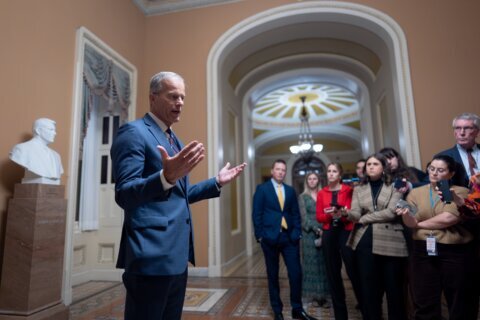WASHINGTON — Newly elected members of the 116th Congress won’t be sworn in until next year, but they’ve already made some history, just by posing for the traditional freshman photo in front of the U.S. Capitol.
The photo reflects a record number of elected women and people of color who won in the midterm elections. They make up the most diverse group of incoming lawmakers ever on Capitol Hill. When Congress convenes in January, at least 35 women will be new members, bringing the total serving in the House and Senate to more than 120 — that’s up from the current 107 in Congress.
The House will have an unprecedented number of African-Americans and Latinos. Veronica Escobar and Sylvia Garcia are the first Latinas from Texas in Congress.
“It’s very exciting. It’s long overdue,” Garcia said this week as she arrived in Washington with others to begin their orientation, start putting together their staffs and figure out where they’ll live. “Diversity is so good and so important for decision-making.”
The freshman class also includes the first two Native Americans elected to the House: Sharice Davids of Kansas and Deb Haaland of New Mexico. And it includes the first two Muslim women in Congress: Ilhan Omar of Minnesota and Rashida Tlaib of Michigan.
“It’s uplifting,” Tlaib said. “People like us are now finally running for office and we’re winning. We’re very hopeful to be able to help our residents back home feel like they have a seat at the table now.” Tlaib and others have posed for photos to celebrate their elections and diversity. Omar tweeted a picture from the House floor:
Started from the bottom, now we’re here. pic.twitter.com/zu2NqMC8AH
— Ilhan Omar (@IlhanMN) November 14, 2018
Democrat Jennifer Wexton will represent the 10th District of Virginia. The commonwealth now has three women representing the state: Wexton, Abigail Spanberger from the 7th District and Elaine Luria in the 2nd District.
“It’s wonderful. It’s a little bit surreal,” Wexton said. “It’s a lot of information, but it’s incredibly humbling and amazing to be part of Congress.”
All but one of the women elected to the House are Democrats. They have a wide range of issues they want to tackle. But virtually all of them say they want to keep making sure there’s affordable health care for Americans.
Some have called this the “year of the badass woman,” since several of the women elected have military and national security backgrounds. Spanberger and Elissa Slotkin, of Michigan, are both former CIA officers. Mikie Sherill, from New Jersey, is a former Navy helicopter pilot.
CNN’s Dana Bash started a series called “Badass Women of Washington” last year, that takes a look at women from a wide variety of backgrounds, who shatter glass ceilings
While the House will be controlled by Democrats next year, Republicans remain in power in the Senate.
Across the aisle?
Incoming House Republicans said they realize they’ll face political challenges in the minority, but still hope to have an impact. And some say they are ready to reach across the aisle.
Republican Denver Riggleman will represent Virginia’s 5th District, which stretches across more than 20 counties, including part of Fauquier County in Northern Virginia. He said he hopes to address staple GOP issues such as tax cuts and immigration, but he also wants to make sure there’s “bipartisan health care.”
“I’m going to work across the aisle if it’s something constitutionally viable [and] something that helps my district,” he said.
While the number of women in Congress is growing, men still hold the vast majority of seats — close to 75 percent. Most Republicans elected in this month’s midterms are white men and GOP leaders have acknowledged they need to do a better job of recruiting women and minorities to run for public office.
Still, the upcoming Congress will look very different. In 1981, when Ronald Reagan was in the White House, 94 percent of Congress was white. Each election in recent years has made Congress more diverse. In 2016, when President Trump was elected, close to one-fifth of voting members in the House and Senate were in a racial or ethnic minority.
The average age of members of Congress is also falling, thanks in part to the election of young newcomers: Alexandria Ocasio-Cortez of New York and Abby Finkenauer of Iowa are both 29; several others are in their 30s, including Spanberger.








